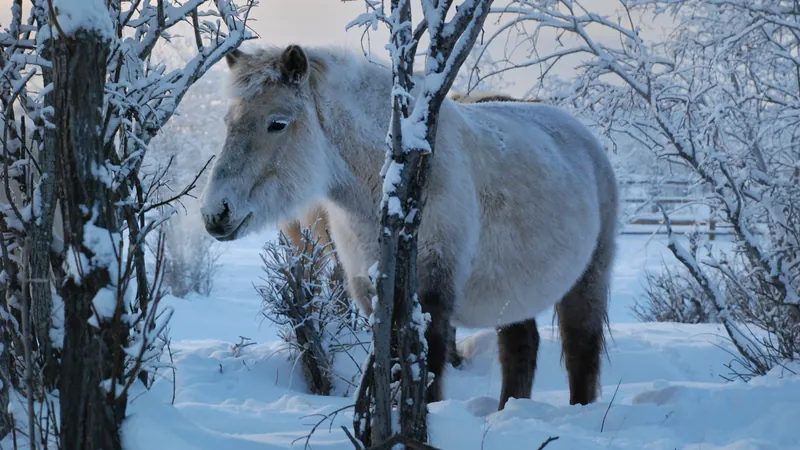
Unlocking the Secrets of the Yakutian Horse: A Journey Through Time and Genetics
2025-09-09
Author: Mei
The Enigmatic Origins of Horses
The origins of horse domestication remain a captivating mystery that scientists are gradually unraveling. As research progresses, evidence reveals how these majestic creatures expanded alongside humanity. In a riveting excerpt from the upcoming book "Horses: A 4,000-Year Genetic Journey Across the World," author Ludovic Orlando delves into the genetic ties between the cold-adapted Yakutian horses and ancient specimens unearthed from a haunting location in Siberia.
The 'Gateway to the Underworld'
Deep in Siberia, over 370 miles from Yakutsk, lies a remarkable crater known locally as the "gateway to hell." Formed by climate change initiated by human activities in the 1960s, this depression has grown into a massive 320-foot deep chasm, revealing the remains of ancient animals as its sides erode.
Among these remains is the famous Lena horse, a remarkable foal that remained perfectly preserved for over 42,000 years. Its features were so detailed that they appeared almost lifelike.
A Genetic Treasure Trove
Though Orlando did not work directly on the Lena horse, he encountered another specimen from Batagay with DNA so well-preserved that it unveiled a high-quality genome sequence, identifying it as a male. Radiocarbon dating suggested it lived around 5,200 years ago, possibly overlapping with the Botai horses. Surprisingly, its genetic makeup did not align with modern domestic horses but traced back to the long-extinct Equus lenensis.
The Yakutian Horse: A Remarkable Survivor
Local legends in Yakutia claim that today’s Yakutian horses descended from wild horses domesticated in the region long ago. To uncover the truth, Orlando and his colleague Andrei Tikhonov studied the genomes of present-day horses in Yakutia. Unlike domesticated breeds, Yakutian horses roam semi-freely across the tundra and taiga.
Key Adaptations for Survival
The stocky Yakutian horse is adapted to its harsh environment, capable of rapidly accumulating fat and slowing its metabolism during the frigid winter without hibernating. This exceptional resilience is shaped by both natural selection and genetic history.
Lessons from the Past
Recent genetic analyses revealed that Yakutian horses share little genetic material with the Lena horse, aligning instead with modern domestic horse lineages that trace back to the western Russian steppes around 4,200 years ago. This supports historical accounts of horse migrations during the 13th century, as horse-riding people fled south from impending threats.
Cultural Significance and Modern Discoveries
In Yakutia, horses are not merely beasts of burden; they are woven into the fabric of local life. From food to clothing, these animals are celebrated in folklore. Yet, the question remains: did Yakutian horses inherit any genes from the Lena horse?
A Clear Conclusion
Genetic investigations concluded that modern Yakutian horses descended solely from breeds introduced in the 13th century. This confirms that while they share the Siberian landscape with remnants of ancient breeds, any genetic mixture had been severed long before.
The Evolution of the Yakutian Horse
As we explore the genomes of today's Yakutian horses, we find adaptations that involve a range of biological functions - from thick hair development to fat storage and metabolic regulation. This evolutionary process, driven by environmental demands, showcases a fascinating dance of survival through genetic diversity.
Unexpected Connections
Intriguingly, some genes discovered in the Yakutian horse also appear in other species adapted to Siberia’s extreme climate, hinting at a shared evolutionary path with both ancient animals like the woolly mammoth and even with us, modern humans. This interconnectedness illustrates the remarkable ways life evolves in response to challenges across time and space.




 Brasil (PT)
Brasil (PT)
 Canada (EN)
Canada (EN)
 Chile (ES)
Chile (ES)
 Česko (CS)
Česko (CS)
 대한민국 (KO)
대한민국 (KO)
 España (ES)
España (ES)
 France (FR)
France (FR)
 Hong Kong (EN)
Hong Kong (EN)
 Italia (IT)
Italia (IT)
 日本 (JA)
日本 (JA)
 Magyarország (HU)
Magyarország (HU)
 Norge (NO)
Norge (NO)
 Polska (PL)
Polska (PL)
 Schweiz (DE)
Schweiz (DE)
 Singapore (EN)
Singapore (EN)
 Sverige (SV)
Sverige (SV)
 Suomi (FI)
Suomi (FI)
 Türkiye (TR)
Türkiye (TR)
 الإمارات العربية المتحدة (AR)
الإمارات العربية المتحدة (AR)